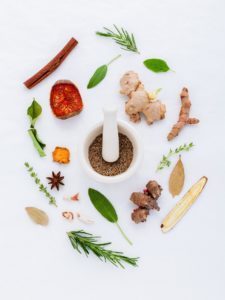
Bottom Line:
Reducing inflammation starts on your plate. Yes, that’s right! The choices you make about what you eat can play a huge role in your body’s hormone balance, immune response and inflammatory state. Each meal is an opportunity to turn up, or turn down, inflammation. With inflammation leading to pain and even chronic disease, it’s best to make good decisions now to reduce your risk of health challenges in the future.
Why it Matters:
Creating an anti-inflammatory diet doesn’t mean you need to make massive changes. As a matter of fact, some simple additions in terms of spices can make a big difference. Adding flavorful spices like turmeric, ginger, and even leafy green vegetables, can improve the health and taste of your next meal.
-Turmeric has been shown to reduce inflammation in people suffering from painful arthritis.
-Ginger can limit the production of inflammatory mediators like cytokines.
-Leafy green vegetables are high in antioxidants.
Next Steps:

The next time you’re getting ready to cook a meal, look for an opportunity to add some anti-inflammatory spices. If you aren’t into food that’s spicy, don’t worry! Spices like turmeric and ginger add more flavor than heat. One final tip is to reduce carbohydrates like bread and increase the amount of green vegetables. These small changes to your meals and diet can pay substantial health dividends down the road!
Science Source(s):
Which herbs help reduce inflammation? Medical News Today. 2019.






